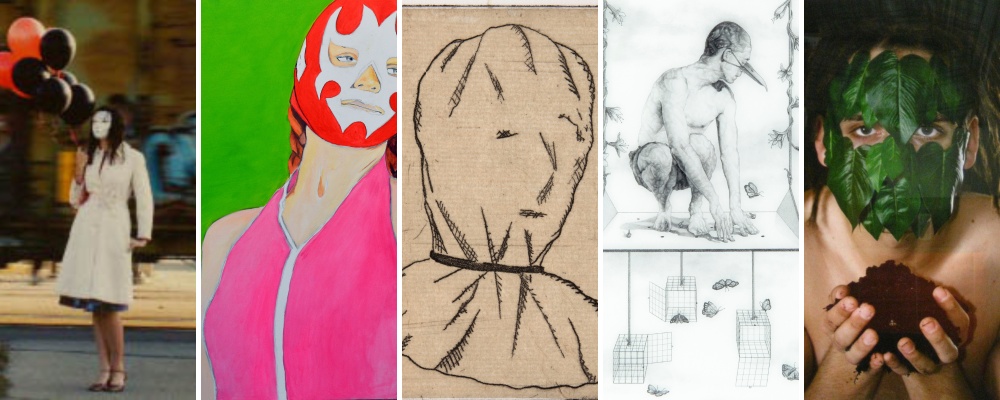Blog
Masks in Art: Identity or Disguise?
October 01, 2023

Images Details (left to right): Megan with Train, Douglas M. Titus, color inkjet print, 2006, 2007.019.1. Untitled, Hugo Claudín, acrylic on canvas, 2007, 2015.67.1. Shroud, Tony Fitzpatrick, etching on paper, 1992, 2017.12.96. Garden Series: Awaiting Flight, Leah Renee Gregoire, pencil on glass, 2018.62.13. Tree Hugger, Bethany Nolin, digital print, 2010, 2010.33.2.
A mask conceals something from view. It can cover part of someone's face or their entire identity. It can be used to disguise, hide, protect, or frighten. A mask can be something that is physically worn, or something we wear metaphorically to change how we present ourselves to the world.
Historically, native people from many cultures created and wore masks for ceremonies to connect and communicate with the spirit world. Diverse cultures created different styles of masks based on materials available or specific beliefs. In some cultures, masks are thought to possess the power of healing. In others, masks are used in rites of passage rituals or used to stimulate fertility, prosperity, or ensure a successful harvest.
Masks, both physically and metaphorically, have also been portrayed in and been inspiration for artwork for centuries. Wooden masks he viewed in a museum had a profound impact on the way Pablo Picasso painted faces. The raw, flat planes of the wood were one of the main inspirations for Cubism; an early 20th century art movement, pioneered by Picasso and George Braque.
While masks are a way to disguise who we are, artists can also use
them to make the viewer think about the identity of someone in a work
of art. A covered face makes a person in an image more generic,
leaving the viewer to question if the artwork is about a particular
person or perhaps represents a larger group. Masks allow the wearer to
become someone else- whether they are trying to hide something or
change the face someone is presenting to the world. Masks can be found
in several artworks in the GVSU collection. Which ones do you think
tell the story of someone hiding behind the mask? Which ones explore
different ways in how we present ourselves?
Douglas M. Titus
Douglas Titus’ photographs investigate the relationship between
the subject, the photographer, and the viewer. The subjects in his
photographs are his friends and family, but he uses masks to erase
their identities so that they become a more universal or archetypal family.
To see more works of art by Douglas M. Titus in the collection visit:
https://artgallery.gvsu.edu/Detail/entities/1892
Hugo Claudín
Hugo Claudín is a Mexican painter who migrated to the United
States as a teenager to continue studying art. This painting from his
series, "Mexicains Sans Frontieres," reflects his binational
status and the secret lives of undocumented immigrants from Mexico. He
uses the Mexican wrestler mask as a metaphor for the unseen
communities of undocumented people living in the United States and for
the misrepresentation in the media, giving them a dignity and cultural
richness that is often overlooked.
To learn more about this artwork by Hugo Claudín visit: https://artgallery.gvsu.edu/Detail/objects/14716
Tony Fitzpatrick
Tony Fitzpatrick is a Chicago- based artist known for his work
inspired by Chicago street culture, tattoo designs, and folk art. In
this etching, Fitzpatrick has created a mask that is disconnected from
a body, though we can still see a face in the creases of the fabric.
Is this a masked person- or a mask that looks like a person?
To see more works of art by Tony Fitzpatrick in the collection visit:
https://artgallery.gvsu.edu/Detail/entities/3189
Leah Renee Gregoire
Local Michigan artist Leah Renee Gregoire’s artwork highlights
the human form through a lens of exploring the Christian relationship
with our modern world. A simple beak mask strengthens the
relationship the anonymous man in her drawing has with nature or the
garden we can assume is around him and these uncaged butterflies, a
setting, as Gregoire states, is "very pivotal for events in
Christian history."
To see more works by Leah Renee Gregoire in the collection visit: https://artgallery.gvsu.edu/Detail/entities/811
Bethany Nolin
While the face may be the most recognizable feature on one’s
body, what Bethany Nolin believes makes up the "soul" of an
individual is a person’s interests, hobbies, and personalities. In
this series of photographs, Nolin physically covers the face with
objects that reflect the person's interests, creating a duality that
conceals their identity, but reflects their inner soul.
To see more works by Bethany Nolin in the collection visit:
https://artgallery.gvsu.edu/Detail/entities/3190
